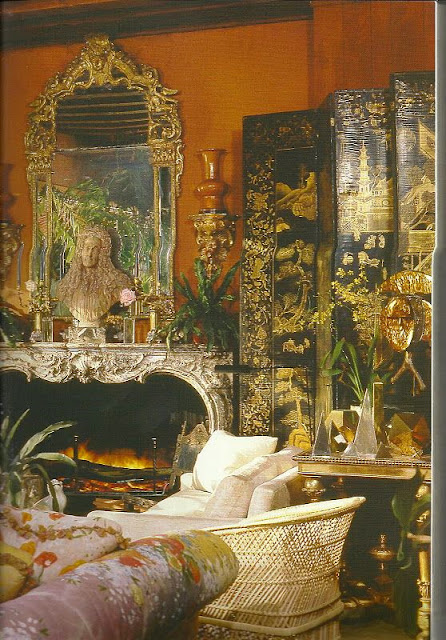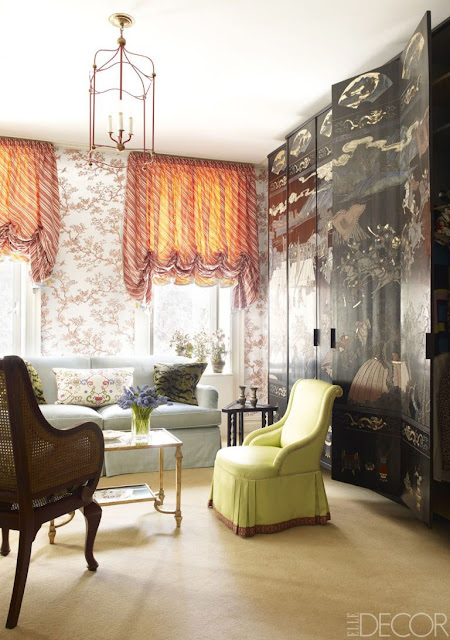The Coromandel screen was originally just a one panel screen instead of the folding screen we think of today. They received their name from India’s Coromandel coast, from which they were shipped to Europe in the late 17th and early 18th centuries by merchants of the English, French East India, and Dutch companies.
The most common type of object made in the style, both for Chinese domestic use and exports was the Coromandel screen, a folding screen adorned with art, major themes included mythology, scenes of Palace life and nature. Europeans were extremely fascinated by the depictions of Chinese palaces and scenes of mountains, pavilions, colorful birds of paradise and flowers that the Chinese artists created.
Coromandel screens were the peak of the fashion for paneling rooms in the late 17th century. By 1700 many European country houses and palaces contained examples of East Asian export lacquer. They remained popular until the 18th century when Chinese wallpaper began to reach Europe, and generally replaced the lacquered Coromandel panels as a cover for walls.
Dodie Rosekran's home decorated by Michael Taylor
A combination of different lacquer techniques are often used in Coromandel screens, but the basic one is kuan cai or "cut colors". A wood base is coated with a number of thick layers of black or other dark lacquer which produce a highly polished effect. Next pictorial shapes are carved out of the lacquer thus creating the fine black outlines and intricate detail on the figures and ornaments. The final surface of the picture element might be painted in colored lacquer or oil paints. This creates that beautiful dimensional design that makes the Coromandel screen so appealing.
A different technique was used for inlays of mother of pearl. The mother of pearl was often engraved and stained with colors. This technique was more expensive and usually just produced for the court.
via Pinterest
These screens can also be inlaid with jade or the more rare jadeite. Jadeite is translucent and truly gorgeous with it's distinctive colors of apple, emerald, leek, blue-green, white, or white with green spots.
Michael Taylor
The main two designs are typically courtly "figures in pavilions", often showing "spring in the Han palace", and secondly landscape designs, often with emphasis on birds and animals.
Nothing can give a room that instant look of Chinoiserie quite like a Coromandel screen does. Chinoiserie means ‘Chinese-esque’ in French, and refers to the influence of Oriental design on European art, architecture, and interior decorating when Chinese objects arrived in the West in the 17th century.
Originally Coromandel screens were not designed with home decoration in mind but to prevent drafts. It was when they were introduced to Europe, in the middle ages, that they were used for ladies to dress behind. The idea to start using them as room partitions was not far behind.
These wonderful screens may boast up to 30 layers of lacquer, sometimes all in black, sometimes red, and sometimes even yellow.
Some Coromandel screens might illustrate historical events. Pavilions were almost always present.
Typically borders run above and below the main scene. These often show antique Chinese objets d'art, sprays of flowers, or a combination of the two. There are often smaller borders between the main image and at the edges.
Usually both sides of the screen are fully decorated with scenes of Chinese life or landscapes.
Coco Chanel was the proud owner or 32 rare Coromandel screens, which she proudly displayed in her home at 31 rue Cambom, Paris. In some areas like seen above, she applied them to the walls like wallpaper.
Another image of Coco Chanel's Coromandel screen collection. She one stated "I've loved Chinese screens since I was eighteen years old. I nearly fainted with joy when, entering a Chinese shop, I saw a Coromandel for the first time."
These beautiful Coromandel screens can actually work well in every room in the house. They only fell out of vogue with the onset of minimalism where the simplest and fewest elements are used as décor. Now with the renewed interest in decoration and ornament, they have made a comeback.
Rose Tarlow
A Coromandel screen can become a great alternative wall. These pieces can be six or seven foot tall designs that can provide a very quick, and fairly inexpensive new wall......one that looks like a work of art.
Anne Getty
Rather than invest large sums of money in making permanent structural changes in a home, people are deciding to buy a beautiful Coromandel screen that can be moved around and used where needed.
Screens are a wise investment because they are easy to move and fit nicely into almost any space. They actually allow you the opportunity to re-create your interiors.
A Coromandel screen is a versatile piece of furniture that has an endless number of functions. Use them as room dividers, to partition off a space, or hide a work area. They can also be used to direct foot traffic.
Coromandel screens can have four, six, and the best of the best screens have eight or more panels.
What a beautiful eight paneled Coromandel screen!
Michael Smith's Madrid home via galeriemagazine.com
Coromandel screens can be quite impressive in size. They are actually large pieces of furniture that are beautiful works of art.
Alberto Pinto
via Pinterest
Coromandel screens are so very versatile and look great in any room of the house.
Dining rooms, according to the interior designer Mario Buatta, are still the most common place to find screens.
Bunny Mellon
A Coromandel Screen, or any other style screen, can be used to create an intimate dining space.
via Pinterest
Alberto Pinto
That is why these Coromandel folding screens can be a decorator's secret weapon!
Since the Coromandel screen is often associated with intrigue and romance in Chinese literature bedrooms are great places to display them. In fact it was customary for a folding screen to surrounded the bed of the young couple. The twelve panels were beneficial for creating privacy.
Miles Redd
When placed in back of a bed they can act as a fabulous headboard.
Imagine this Coromandel screen used in a bathroom to conceal a toilet.
Coromandel screen also are a quick way to add texture and color to a room.
Gary Riggs, designer
If you have a problem wall that needs disguising try purchasing a Coromandel screen. They can easily hide a multitude of sins quite beautifully!
Designer Jeffrey Bilhuber
Or use one to hide a messy desk or an unmade bed when unexpected guests drop by.
This is a great time to buy as their popularity is only now on the upswing after a few years of being in the scorned and rejected areas.
Click here to see the previous post
This blog post was published by Lisa Farmer
In the event that I have not credited the correct source of an image, please contact me at lisafarmerdesigns46@yahoo.com and I would be glad to correct it.










































